Natural Rearing - Accommodation
Whilst
baby tortoises have identical requirements in terms of environment and diet to
adult tortoises, because of their small size and relative vulnerability, they
must be contained and protected a little more.
Accommodation
The aim should be to imitate as closely as possible the wild environment whilst enhancing our poor season and protecting from predators.
Tortoise rearers have devised various methods including units on workbenches with planted seed trays, brick-built raised beds and enclosed garden runs with access to part of a greenhouse, conservatory or cold frame. The precise construction and location or yours depends on the layout and aspect of your garden - a really sunny and safe spot is needed.
Barriers should be opaque or they will try to get through them and netting should be avoided as tortoises use it like a ladder!
Access to the outside is absolutely essential. The babies should be outside whenever it is warm enough even if not sunny as they need UV light to properly metabolise their food. Remember UV does not pass through glass or plastic. They can cope with rainy days too, if part of their area is glass or plastic covered and the ambient temperature is warm enough though they will only behave really naturally on sunny days.
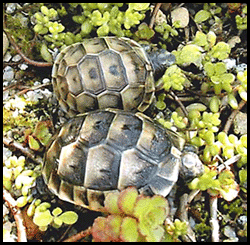
It
is vital to keep stress to a minimum; the less interference there is with their
daily lives, the happier and healthier they will be. To achieve this you need to
prepare a secure sided outdoor unit or area chosen for its sunny position (all
day if possible) with rocks, gravel and soil, planted with food plants
and shelter shrubs, with a small sleeping cave (protected from wet) and a
shallow, wadable water pot.
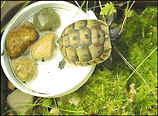
A
light open mesh should be placed over the unit to protect against dogs, cats,
foxes or large birds but try to keep shadow to a minimum, though of course some
shade is absolutely essential.
Points
to bear in mind: Bigger is better, grass is a nuisance and they enjoy clambering
and burrowing. They are also very good escapers - take special care with corners
which they use as rock climbers u
A
raised up unit will be more secure, easier to tend
and catch the sun for more hours. The tortoises can certainly be left outside at
night in summer in a wooden house or stone cave but do protect from rain, foxes,
hedgehogs, etc.
An
outdoor Workbench Unit for h
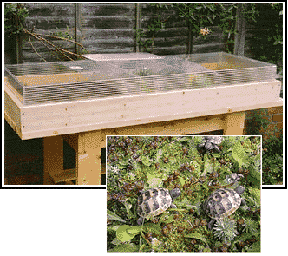
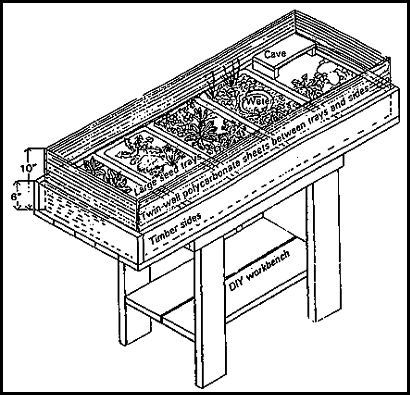
Materials
•
Cheap, ready to assemble, wooden workbench (from DIY store).
•
4 lengths of wood for the sides, 10" deep (avoid toxic wood preservatives)
•
5 large plastic seed trays with holes (These are quite expensive but
convenient for planting and replacing. Alternatively make an inner wooden
wall where the edges of the trays would be and plant directly onto the
bench.)
•
Clear twin wall polycarbonate sheeting, 6" deep, to slot between the trays
and the sides.
•
White plastic covered mesh panels or clematis support for the top.
•
Glass or plastic sheet or small double-glazing panel.
•
Rocks, soil, gravel, food plants, shelter plants, sleeping cave, water dish.
Safety
and security
are important factors to consider. The unit or enclosure must be totally tortoise
proof
from inside, animal proof
from outside and should be sited where not
overlooked
from the road where it could invite theft. Protection
from dogs, toddlers and footballs is required!
Outdoor
accommodation
As the babies grow bigger they will grow out of their raised unit and should be provided with a good sized and securely enclosed sunny area of the garden in which their food plants grow and there is ample basking for a good portion of the day.
They need some stony ground or concrete as well as soil and grazing areas, plants and rocks to shelter under and climb on, and a shallow water pot.
My own juveniles have an area which is sloped towards the sun and surrounded by a low brick wall, enabling the soil level to be raised inside.
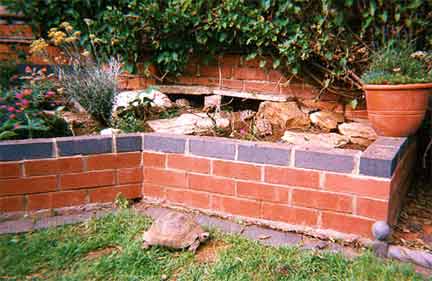
If
space allows, consider a tall net fruit-cage which
offers complete protection
and ease of access for you.
Indoor
accommodation
All the methods I have described are for the outside; but some form of indoor unit is needed too, particularly during the spring and autumn months to extend our short summer at either end, as only about 11 weeks hibernation is advisable for youngsters.
When they are bigger various good solutions can be devised combining a greenhouse or conservatory with access to the outside so they can choose to either go out when it is warm enough, or bask inside when cool.
Whilst they are young though they will need an indoor unit equipped either with Full Spectrum strip such as ‘Reptisun 5’ by Zoomed plus a basking light, or the new ActiveUV Heat and Zoomed Powersun bulbs which combine the benefits of a Full Spectrum light and basking light in one. These are proving very successful, producing a superior level of UV far closer to natural sunlight than the strip lights and are highly recommended.
The best substrate I have found is a towel stretched over the base - they can grip it with their claws to right themselves if they capsize and it can be washed in the machine (without detergent). More towels can be formed into 'hills' to climb on, shelter under and burrow into, and to form ramps up to planted seed trays.
It is a good idea to provide a flat stone or slate to keep claws from overgrowing. If the tortoises’ food is placed on this, it will also ensure that their beaks are kept naturally trimmed, as when grazing outside. Whilst well able to tolerate low humidity conditions in the wild, they do appreciate an occasional lukewarm shower with a fine rose watering can when out in the sun and should be 'misted' about twice a day when in indoor units to prevent over-drying and so avoid eye and respiratory problems.
Clean
water
should always be available.
Constructing
Many people assume that a glass fish tank will make an ideal vivarium for young tortoises, but in my experience these are unsuitable and should be avoided.
Something
which is more
open and airy
provides a healthier atmosphere and is easier to keep clean.
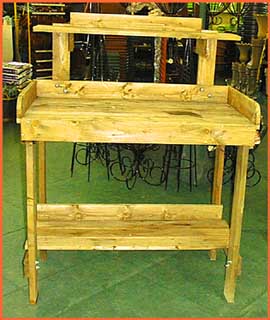
This potting bench, found in a garden centre, needs little more than slightly higher walls and a front strip, to be ready to use and is a cheap and easy option.
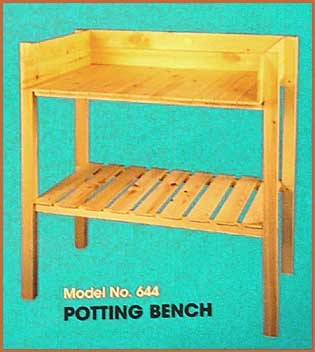
This smaller, light-weight one from Parasene Garden Products just needs a front panel and is not treated with anything harmful to animals.
If using a ready-made bench, do please ensure that the wood has not been preserved with harmful chemicals.
Alternatively, here is a way of making your own:
Making
a Tortoise table
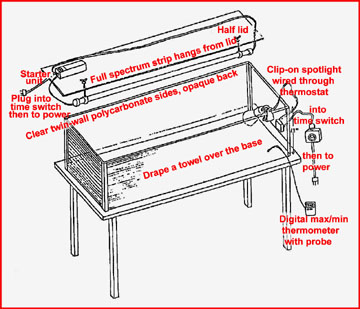
A simple and effective indoor unit can be made on a tabletop (a school desk about 4' x 2' makes a good base) with low twin-wall polycarbonate or clear plastic walls fixed at the comers, and a towel stretched over the base to give firm footing. Add another towel for climbing on and hiding under plus a heavy shallow water pot.
Heat and light; old method: Make a half-lid from which to hang a full-spectrum strip light suitable for reptiles (e.g. ‘Reptisun’ by Zoomed) and a starter unit for it which can rest on top. This light should not be further than 8" above the tortoises to be effective and should be replaced after 6 months use. For basking heat, provide an ordinary clip-on spotlight (40 or 60 watt) firmly fixed to the edge so that the bulb is not much more than 12" above them and set at an angle. Arrange the two lights so that they shine on the same area.
A simpler and more effective arrangement is to use a 160 watt Active UV Heat or Zoomed Powersun flood lamp as shown in the nursery unit below, which combines heat and UV. These bulbs are relatively expensive but are effective for two years. They cannot be run through a thermostat but in an open-topped unit this is not a problem. (Note that the lamp should be no higher than 12 or 15 inches above the tortoises and that the lamp is higher in the picture just for the purposes of the photo.)
It is vital to provide a temperature gradient within the unit so the tortoises can thermo-regulate. They need a cool spot with shelter at room temperature (approx 20ºC) as well as the hot spot under the basking lamp (approx 30-35ºC). Similarly a daily temperature cycle is important so the night-time temperature should be allowed to drop to normal room temperature (approx 17-20ºC) at night, just as in the wild.
Use a probed thermometer (as described for monitoring hibernation), to establish the best height for the lamp and a time switch to control day length.
A 'Ttable' in use
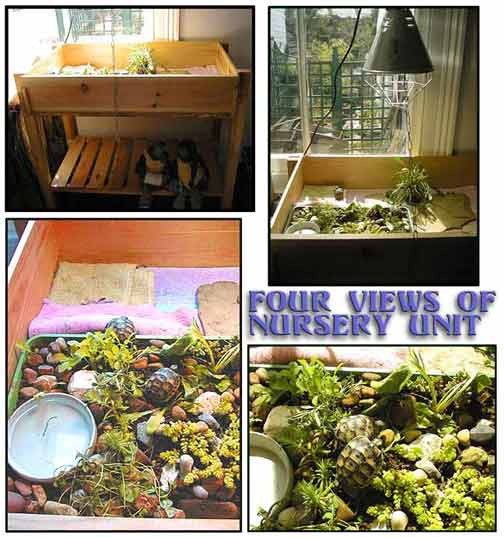
All graphics and text in this site © L King 1998-2007